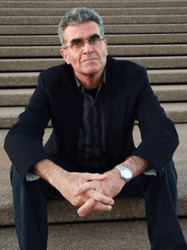The Heavenly Temple
March 1, 2007
One of the saddest things a visitor to Jerusalem will see is the Wailing Wall and the many devout Jewish worshippers standing before the only remaining ruins of their ancient temple destroyed in A.D. 70 by Roman armies. For hours the worshippers rock backwards and forwards, holding portions of their Scriptures, praying earnestly. In between the cracks of the stones enduring before them can be seen many pieces of paper containing prayers for the restoration of the building that was a symbol and focus of their faith for about fourteen centuries before its destruction.
Just before these tragic events, a divinely inspired letter was written to the Hebrew Christians urging them to understand the real significance of this magnificent structure in view of the death and resurrection of Jesus. Hebrews 9:1–14 gives a thumbnail description of the Jewish sanctuary and its services as previously outlined in specific detail in the Bible’s books of Exodus and Leviticus.
That sanctuary had one distinct purpose: that God might dwell in the midst of His people (see Exodus 25:8).
He manifested His presence in the second apartment of the sanctuary, called the Most Holy Place, and appeared in a bright shining glory called the “kabod” or “shekinah.” When the temple was dedicated, that glory descended with such power that Moses could not enter the dwelling. The Israelites knew the presence of God was there by a cloud that hung over the structure every day and a pillar of fire by night.
In Hebrews, chapter 9, this building is called an “earthly” sanctuary that had been patterned after a true tabernacle set up by God in “heaven” (see Hebrews 8:1–5). Moses had been given specific directions on the nature and dimensions of every aspect of the sacred venture. Its structure and ordinances were all designed to be a shadow of the Messiah’s ultimate redemptive work for us in heaven.
Of all the ongoing services carried out repeatedly throughout every year of the Jewish calendar, the Holy Spirit focuses on one basic lesson He wants Christians to learn (see Hebrews 9:8, 9). He desires us to realise that so long as the old earthly sanctuary still maintained a meaningful standing with God’s people, their access to the presence of God was severely limited.
The ordinary Hebrew citizen could bring his offerings only as far as the outer court of the temple where they were sacrificed. It was then up to a priest to take some of the blood of that sacrifice into the first apartment (called the Holy Place) of the sanctuary. But even he did not have access to the presence of God. He could only take the blood as a symbol of Israel’s sin and place it on the horns of a small altar, the altar of incense, in front of a barrier before the Most Holy Place.
This happened every day of the year except for one climactic day, the Day of Atonement, when the high priest alone was able to enter the second apartment— into the actual presence of God.
The ordinary priests were denied direct access to God by a thick, heavy curtain.
But for a brief period of time the high priest was able to take the accumulated sin of the nation symbolised by the blood of an animal sacrifice and place it on the mercy seat. The ark itself contained the absolute moral law of God inscribed on tablets of stone.
The Most Holy Place on earth represented Jesus’ ministry for us in heaven, the “true” Most Holy Place.
“[Our hope] enters the inner sanctuary behind the curtain, where [He]…went before us, [and] has entered on our behalf. He has become a high priest forever” (Hebrews 6:19, 20). He has sat down at the right hand of the “throne” of the Majesty in heaven (Hebrews 8:1) where we can receive “mercy” at the heavenly mercy seat, and grace, in the time of need for forgiveness of sins (Hebrews 4:16).
What this means is that our con sciences can now really be cleansed from sin and guilt (see Hebrews 9:14).
The old sacrificial system was only ritualistic, and because it had continually to be repeated, it is evident that it was ineffective (see Hebrews 9:25, 26).
Satan is called the “accuser” of God’s people (see Revelation 12:10; Zechariah 3:1) and constantly wants us to believe that our sins can never be forgiven.
The crux of Christianity is to grasp that Jesus’ sacrifice of Himself has achieved the forgiveness of our sins; and if that is so and we have claimed that forgiveness for ourselves by faith as He asks us to, then there is no reason for our consciences to trouble us any more regarding any sin in the past.
Therefore, because Jesus has gone right into the presence of God, we can also go there with Him if we are “in” Him. Jesus was the real presence of God with us. He came and “tabernacled” among us (see John 1:14). The Shekinah glory from the sanctuary of old—the very presence of God—was covered in ordinary human flesh, and His name was Jesus.
Speaking of His own body, Jesus said to the Jews of His day, “Destroy this temple, and I will raise it again in three days” (John 2:19). When the Roman soldier thrust a spear into the heart of Jesus on the cross, God’s heart was revealed visually to all people for the first time. The tearing of the literal curtain before the Most Holy Place in Jerusalem at that time (see Matthew 27:51) marked the tearing of His body (see Hebrews 10:19–22).
Every human being now has direct access to the presence of God, and we may enter in with complete confidence and the assurance of faith. It was that sort of reality that enabled the apostle Paul and the New Testament Christians to approach God no matter how severe their personal situation might have been (see Ephesians 3:12–14).
That so many people today still fail to recognise this is the great tragedy of the Wailing Wall in Jerusalem.









